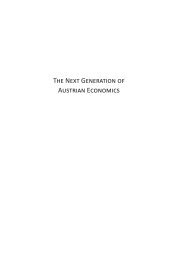capitalist_and_entrepreneur_klein
capitalist_and_entrepreneur_klein
capitalist_and_entrepreneur_klein
Create successful ePaper yourself
Turn your PDF publications into a flip-book with our unique Google optimized e-Paper software.
32 <br />
Economic Calculation<br />
All <strong>entrepreneur</strong>s, particularly <strong>capitalist</strong>-<strong>entrepreneur</strong>s, use economic calculation<br />
as their primary decision-making tool. By economic calculation<br />
we simply mean the use of present prices <strong>and</strong> anticipated future prices to<br />
compare present costs with expected future benefits. In this way, the <strong>entrepreneur</strong><br />
decides what goods <strong>and</strong> services should be produced, <strong>and</strong> what<br />
methods of production should be used to produce them. “e business<br />
of the <strong>entrepreneur</strong> is not merely to experiment with new technological<br />
methods, but to select from the multitude of technologically feasible methods<br />
those which are best fit to supply the public in the cheapest way with<br />
the things they are asking for most urgently” (Mises, 1951, p. 110). To<br />
make this selection, the <strong>entrepreneur</strong> must be able to weigh the costs <strong>and</strong><br />
expected benefits of various courses of action.<br />
As discussed in the previous chapter, the need for economic calculation<br />
places ultimate limits on the size of the organization. Indeed, many writers<br />
have recognized the connections between the socialist calculation debate<br />
<strong>and</strong> the problems of internal organization (Montias, 1976; Williamson,<br />
1991c). Kirzner, for example, interprets the costs of internal organization<br />
in terms of Hayek’s knowledge problem:<br />
In a free market, any advantages that may be derived from “central<br />
planning” ... are purchased at the price of an enhanced knowledge<br />
problem. We may expect firms to spontaneously exp<strong>and</strong> to the<br />
point where additional advantages of “central” planning are just<br />
offset by the incremental knowledge difficulties that stem from dispersed<br />
information. (Kirzner, 1992, p. 162)<br />
What, precisely, drives this knowledge problem? e mainstream literature<br />
on the firm focuses mostly on the costs of market exchange, <strong>and</strong><br />
much less on the costs of governing internal exchange. e new research<br />
has yet to produce a fully satisfactory explanation of the limits to firm size<br />
(Williamson, 1985, chap. 6). In Coase’s words, “Why does the <strong>entrepreneur</strong><br />
not organize one less transaction or one more?” Or, more generally,<br />
“Why is not all production carried on in one big firm?” (Coase, 1937,<br />
pp. 393–94). Existing contractual explanations rely on problems of authority<br />
<strong>and</strong> responsibility (Arrow, 1974); incentive distortions caused by<br />
residual ownership rights (Grossman <strong>and</strong> Hart, 1986; Hart <strong>and</strong> Moore,<br />
1990; Hart, 1995); <strong>and</strong> the costs of attempting to reproduce market gov-








